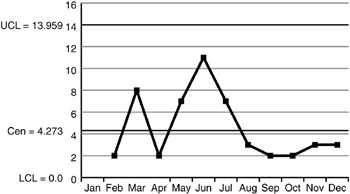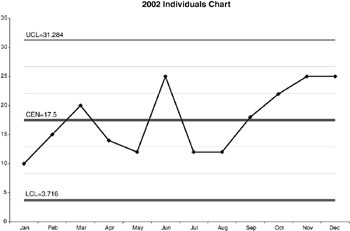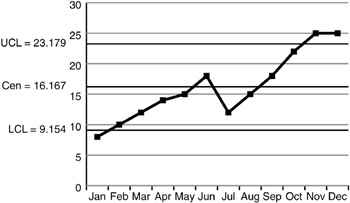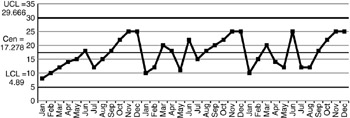Hints on How to Read the Charts
The Moving Range Control Chart
Which chart should I use? Although others may disagree , we recommend that you use the Average Moving Range (XmR) chart for most situations because:
-
It is easy to use.
-
It is easy to understand.
-
It is easy to implement.
-
It is most often the most appropriate for use in an organization.
-
It is the most-often found and most-often used chart in high-maturity organizations.
There are automated tools that can support building and displaying these charts . But remember: a tool does not do the thinking for you. It is up to you to collect the data correctly, to collect the correct data, and to interpret the results correctly.
Another suggested reason for using the XmR chart: Do you understand the terms "binomial probability" and "Poisson probability"? Do you know how to verify these probability models? If the answer is "No" or "What kind of language are you speaking?," then stick with the XmR. Life is complicated enough.
The task we need to undertake is to figure out how to tell the difference between noise and signals. Properly generated control charts, specifically the XmR chart, can help us in this task. Past data (historical data) are critical for generating accurate control charts and for correct SPC analyses. To determine whether the results found are normal noise or true signals, comparisons of past data limits must be made, and moving ranges determined. What is a moving range? Variation between successive values. For example, Exhibit 8 shows the count for each month of the year 2002. The mR values (moving range) show the difference between the counts for the various months.
| |
| Month | Jan | Feb | Mar | Apr | May | Jun | Jul | Aug | Sep | Oct | Nov | Dec |
|---|---|---|---|---|---|---|---|---|---|---|---|---|
| 2002 | 10 | 15 | 20 | 14 | 12 | 25 | 12 | 12 | 18 | 22 | 25 | 25 |
| mR Values | 5 | 5 | 6 | 2 | 13 | 13 |
| 6 | 4 | 3 |
|
| |
We can then average the moving ranges (Exhibit 9). Add up all of the moving ranges and divide by the number of months differentiated (11), and we come up with 5.18 for our average moving range. The centerline shows the average moving range for Exhibit 8. The upper limit is 16.93.
| |

| |
Moving ranges for calendar year 2001 are shown in Exhibit 10. We then average the moving ranges. Add up all of the moving ranges and divide by the number of months differentiated (11), and we come up with 4.27 for our average moving range. The centerline in Exhibit 11 shows the average moving range for Exhibit 10. The upper limit is 13.96.
| |
| Month | Jan | Feb | Mar | Apr | May | Jun | Jul | Aug | Sep | Oct | Nov | Dec |
|---|---|---|---|---|---|---|---|---|---|---|---|---|
| 2001 | 10 | 12 | 20 | 18 | 11 | 22 | 15 | 18 | 20 | 22 | 25 | 25 |
| mR values | 2 | 8 | 2 | 7 | 11 | 7 | 3 | 2 | 2 | 3 | 3 |
| |
| |

| |
Moving ranges for calendar year 2000 are shown in Exhibit 12. We then average the moving ranges. Add up all of the moving ranges and divide by the number of months differentiated (11), and we come up with 2.64 for our average moving range. The centerline in Exhibit 13 shows the average moving range for Exhibit 12. The upper limit is 8.61.
| |
| Month | Jan | Feb | Mar | Apr | May | Jun | Jul | Aug | Sep | Oct | Nov | Dec |
|---|---|---|---|---|---|---|---|---|---|---|---|---|
| 2000 | 8 | 10 | 12 | 14 | 15 | 18 | 12 | 15 | 18 | 22 | 25 | 25 |
| mR values | 2 | 2 | 2 | 1 | 3 | 6 | 3 | 3 | 4 | 3 | 3 |
| |
| |

| |
While these charts are clear and easy to understand, they do not tell us enough of the story. To make these charts more relevant, we need to include a corresponding chart for the individual values represented by the individual months for each year in order to show a correlation or relationship between the values displayed. Are these good numbers or bad numbers ? The charts will help us decide.
The centerline shows the average of the individual values (the sum of the values for the individual months divided by 12). Please review Exhibits 14 through 19.
Using the information in Exhibit 14, we produce the chart shown in Exhibit 15. The centerline is 17.5. The upper limit is 31.28 and the lower limit is 3.72.
| |
| Month | Jan | Feb | Mar | Apr | May | Jun | Jul | Aug | Sep | Oct | Nov | Dec |
|---|---|---|---|---|---|---|---|---|---|---|---|---|
| 2002 | 10 | 15 | 20 | 14 | 12 | 25 | 12 | 12 | 18 | 22 | 25 | 25 |
| mR values | 5 | 5 | 6 | 2 | 13 | 13 |
| 6 | 4 | 3 |
|
| |
| |

| |
Using the information in Exhibit 16, we produce the chart shown in Exhibit 17. The centerline is 18.17. The upper limit is 29.53 and the lower limit is 6.8.
| |
| Month | Jan | Feb | Mar | Apr | May | Jun | Jul | Aug | Sep | Oct | Nov | Dec |
|---|---|---|---|---|---|---|---|---|---|---|---|---|
| 2001 | 10 | 12 | 20 | 18 | 11 | 22 | 15 | 18 | 20 | 22 | 25 | 25 |
| mR values | 2 | 8 | 2 | 7 | 11 | 7 | 3 | 2 | 2 | 3 | 3 |
| |
| |

| |
Using the information in Exhibit 18, we produce the chart shown in Exhibit 19. The centerline is 16.17. The upper limit is 23.18 and the lower limit is 9.15.
| |
| Month | Jan | Feb | Mar | Apr | May | Jun | Jul | Aug | Sep | Oct | Nov | Dec |
|---|---|---|---|---|---|---|---|---|---|---|---|---|
| 2000 | 8 | 10 | 12 | 14 | 15 | 18 | 12 | 15 | 18 | 22 | 25 | 25 |
| mR values | 2 | 2 | 2 | 1 | 3 | 6 | 3 | 3 | 4 | 3 | 3 |
| |
| |

| |
Now we can combine the values for all of the charts for all of the years into two charts: one for Individual Values for all three years (Exhibit 20), and one for the Average Moving Ranges for all three years (Exhibit 21) ” and compare the two.
| |

| |
| |

| |
In Exhibit 20, the centerline is 4.66. The upper limit is 15.21. Notice that lower limits are not calculated for Average Moving Range charts. This is because the calculation would result in a negative value and a range cannot be negative.
In Exhibit 21, the centerline is 17.28. The upper limit is 29.67. The lower limit is 4.89. You can clearly see cycles in this chart. The line for December to January shows a precipitous drop that appears to occur every year. The line for February begins a climb back up. The line for March to April goes downward. The line for May goes back up. June and July are down. July to December is up. The chart does not tell us why, but we can clearly see that something is happening. We need to investigate that something to determine what is going on.
EAN: 2147483647
Pages: 205